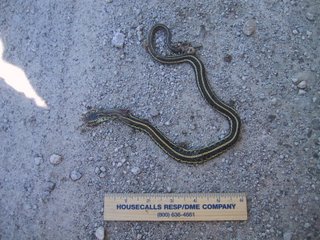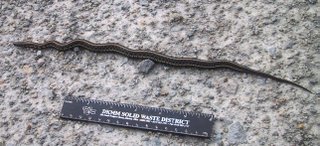Saturday, August 26, 2006
Hey, Aqualung
The Queensland (or Australian) lungfish, Neoceratodus forsteri, is a fish with, as its name suggests, a lung (living in Queensland, Australia is secondary). This is to help it manage when levels of dissolved oxygen in the water are low, which is likely to happen in the slow-moving pools that it inhabits. It is completely aquatic, in contrast to African or South American lungfish (with two lungs) that spend entire dry periods burrowed in a mucous cocoon with an airhole to the surface. However, N. forsteri can spend hours out of water if it's kept moist, according to this study.
Appropriately described as "a living fossil," lungfish certainly look the part. They can grow up to three or four feet in length, and have large, platelike scales and fins that look ready to attempt to flop onto land. In Australia, lungfish fossils dating back 100 million years (when our mammal ancestors were running from Compsognathus) have been found, and there are minimal differences. The Queensland lungfish, even moreso than the other lobe-finned fish, helps give an idea of how the water-land transition happened in vertebrates about 370 million years ago1.
Alright, so it's not endangered, it's threatened. They are very long lived, which, in population terms, means slow to reproduce. The majority of problems facing the lungfish are actually facing the eggs.Invasive tilapia prey on the young and eggs. Also,dams on the rivers in which they live flood out the vegetation in which they breed. I've seen links to this petition, but I'm trying to be more of an educator than activist (and I linked to it anyway).
There doesn't seem to be any official Queensland lungfish breeding programs in existence. There are, however these guys, from whom you can buy a baby lungfish for just $850! Don't forget to buy the 6 foot tank. They are CITES approved, whose job is to check up on the trade of threatened and endangered species. Breeding for pets is not the way to save animals in the wild, so programs on releasing lungfish and saving habitat are the way to go. Kids! Just be sure to ask your parents nicely for a lungfish. And say please and thank you.
1As a somewhat random aside, I want to point out that flies are never described "living fossils," even though they were in their modern form a good 100 million years before the lungfish.
Saturday, August 19, 2006
Death in the Fast Lane
Now, if anyone is reading this in any state from Indiana to Montana to Kansas, inclusive, and has a knowledge of local snakes, you're probably thinking "Plains garter? Endangered? We've got tons of 'em!" Yes. Yes you do. But if you'll look at the range posted on ODNR's website about them, you'll see a tiny dot in northwestern central Ohio. That is Killdeer Plains Wildlife Area, where I spent much of my high school career.
Visually, the plains garter is nothing too impressive. It gets to be at most 2 feet long, which you can compare to the harmless black rat snake at 6 feet. In terms of coloration, I was hard pressed to tell it from the common eastern garter snake. The difference consists of a row of dots under the lateral stripes on the plains garter. It is even behaviorally unobtrusive, as it manages to be less likely to bite than the common garter snake, which I have picked up dozens of times without getting bitten. Its preferred habitat is, of course, plains and praries, but more specifically, near the ponds and drainage areas to be found in such habitat. Food sources for the plains garter include large insects and small rodents (agricultural pests, if anyone's wondering why we should save these snakes), along with amphibians and earthworms.
A threat facing many endangered species, habitat loss, is what has endangered the plains garter snake in Ohio. We're already at the eastern edge of its range, and the conversion of more and more prairies into developed land, agricultural fields, or even forests, has led to fewer numbers of plains garters.
Another issue plaguing these snakes is traffic, which is how I became came to know of the plight of this species. As a freshman in high school, I wanted a science fair project where I could do research on wildlife. I managed to get in touch with the contract herpetologist with ODNR, and he suggested that I perform a road mortality survey at Killdeer Plains Wildlife Area. Consequently, for the next four years, my fall season was spent by peeling dead snakes off the road. A few unfortunate specimens were the plains garter. This is why many of the pictures I have of them look like this:
 |
| Image by me |
 |
| Image also by me |
A short note on biodiversity:
I have mentioned that plains garter snakes look a great deal like common garter snakes. They also both live in similar areas. They eat about the same thing (earthworms, small rodents, frogs), but a study in the late '70's showed that there were plenty of those to go around, so there's no competition for food. "Hey," says the contrarian, "why do we need two of these, if they fill the same niche? Why do we need to save the one, if there's another just like it?" Well, they aren't exactly alike. There are habitat differences (the common garter snake is a habitat generalist), along with many genetic differences that don't show up in ecological research. What happens when a disease comes by and takes out a large number of common garter snakes, but the plains garter is immune? You'll be glad it's there, helping keep the rodent and insect population in check.
Thursday, August 17, 2006
Please Allow Me to Introduce Myself
Take a good look at the WWF website, (World Wildlife Fund, not the other one) and what do you see? The giant panda, of course. Tigers. Gorillas. Cetaceans. The token reptile, a sea turtle. Generally cute and/or fuzzy, or, failing that, sleek and "handsome". Notice a pattern?
Well, the purpose of this blog is to change all that. Sure, cute fuzzies will sell calendars and mugs, but what about those endangered things whose faces even a mother might have issues loving? Just because they're ugly doesn't mean they're not important. Don't they deserve some attention?
This idea started with an essay. I'll blame the online college application process for saying "...or come up with your own topic!" After having written too many essays about peeling snake carcasses from the road for scientific study (more on that in a later post), I decided to take a different route. Pulling up the Ohio Endangered Wildlife List, I discovered that among the listings was a species of midge. A midge! You know, the relatively inconspicuous insects that go largely unnoticed by anyone except entomologists--unless you're swatting at a cloud of them. If that wasn't enough, they were joined by endangered lampreys, beetles, clams, and some of the aforementioned snakes. Well, that settled it. These were as imperiled, and at least as important as the black bear, whose stories have peppered state news. Where were the American burying beetle news features? The "Save the Wartyback Mussel" t-shirts? The
Thus was born the concept of Endangered Ugly Things, whose goal is to promote awareness of all things both rare and repulsive. However, it currently consists of two members: me, who came up with the idea, and my summer roommate, who said "Y'know, you should make a Blog about that." So, here I am, to promote those endangered things with no good looks, charm, or possibly even appendages, and to give them their time in the spotlight.
I plan on updating with new profiles of Endangered Ugly Things every weekend. I'd be glad to hear of any news concerning "EUTs", or suggestions for an upcoming profile.

